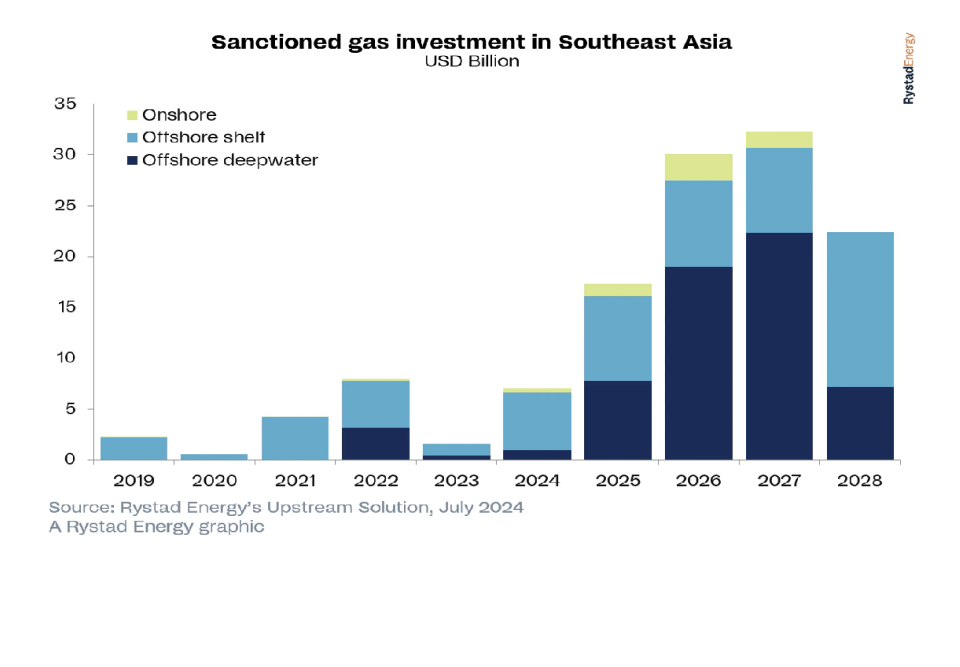Offshore gas production in Southeast Asia may be adding close to a US$100 billion to raise the country’s economic fortunes, to be driven by a flurry of planned final investment decisions (FIDs) expected to materialize by 2028, Rystad Energy’s latest analysis was said to have revealed. Report also indicates that this development represents a more than twofold increase over the $45 billion worth of developments that reached FID from 2014 to 2023 and signals a surge for the region’s offshore gas industry. The report adds that the upcoming period of rapid growth has been bolstered by deepwater projects, discoveries in Indonesia and Malaysia, as well as positive carbon capture and storage (CCS) advancements, which will be crucial in meeting the region’s sanctioning agenda in the years ahead.
The report also indicated that close to 25% of the planned investment through to 2028 would be driven by oil and gas majors, as national oil companies (NOCs) are expected to account for a 31% share, noting that East Asia’s upstream companies are emerging with a 15% share while showing potential for growth by their focus on mergers and acquisition (M&A) opportunities that now define the upcoming exploration ventures. It is also expected that the role of majors could expand further to 27% following TotalEnergies’ substantial acquisition efforts in Malaysia.
All the while according to the report, attention and discussions among Southeast Asian countries have been on the future of domestic developments so as to limit their dependence on gas imports. Adding that energy security and the transition to gas as a fuel have been of growing concern for governments in the region.
Report however added that though the region has been making efforts to develop its offshore gas, persistent project delays have stood as cogs – deepwater and sour gas economics, infrastructure readiness and regional politics – all have caused untold delays – for over two decades. However, they see the emergence of CCS hubs in Malaysia and Indonesia as a relief and game-changer. For sure the high carbon dioxide (CO2) content in upcoming offshore projects necessitates CCS for financing and regulatory compliance, the report noted. Further adding that as at the moment, both countries are exploring depleted reservoirs from mature fields as potential CO2 storage sites. Maintaining that the growing recognition of these reservoirs’ potential, combined with the pressing need for emissions reductions, is significantly boosting demand for CO2 storage and fueling a surge in offshore gas development expected from 2025 onwards.
“We recognize the potential of new project investments and capital commitments in the region, which surged from $9.5 billion in 2022-2023 to approximately $30 billion in 2024-25. As we delve deeper into the data, it becomes increasingly clear that this upward trajectory is expected to continue until 2028. Recent discoveries and the involvement of NOCs will play a vital role in this growth, particularly in deepwater developments, which are pivotal in determining how much of this anticipated $100 billion boom can be realized.”
According to the report, Indonesia stands out with expectations to accelerate its offshore gas activities, to be driven by major projects such as the Inpex-operate Abadi LNG, Eni’s Indonesia Deepwater Development (IDD) and BP’s Tangguh Ubadari Carbon Capture (UCC). Adding that these initiatives, along with recent discoveries in the East Kalimantan and Andaman provinces, are projected to account for 75% of Indonesia’s total offshore gas investments slated for FID. “This significant increase positions Indonesia as a formidable contender to Malaysia’s established dominance, although Malaysia continues to maintain robust activity levels with recent FIDs, exploration success and planned exploration efforts.”
Indonesia anticipates increased FID activity starting in 2025, bolstered by major projects spearheaded by global players like BP and Eni. Malaysia’s upcoming FID projects also underscore significant discoveries made since 2020, primarily managed by Petronas, PTTEP and Shell. Across Southeast Asia, more than half of planned gas projects contain CO2 content exceeding 5% and are predominantly managed by NOCs and other major international companies, with cluster development strategies for deepwater projects, data centers and EVs in the US trending, while the displacement of coal continues in the generation mix.
The region’s gas sector anticipates substantial growth, with projected gas resources from FIDs set to rise to 58 trillion cubic feet (Tcf) by 2028, marking a three-fold increase from levels observed in the past 5 years, 2019-2024. Growth also said to hinge on efficiently monetizing recent discoveries and advancing delayed developments. Notwithstanding a favorable investment climate, operators are however said to be facing economic challenges, especially in deepwater and sour gas ventures. Rystad Energy’s analysis had also indicated that many projects would require gas prices above historical averages of $4 per thousand cubic feet to achieve profitability, with an optimal threshold closer to $6 per thousand cubic feet.
With the economic realities, discussions according to the report now tend focus on revising domestic gas pricing policies across the region, with a gas price of $7.5 per thousand cubic feet to potentially make up to 95% of planned developments economically viable, especially around those associated with LNG projects in Indonesia and domestic supply initiatives in Vietnam. Expectedly, supply chain companies could see increased value for floater-based projects and deepwater drilling, adding motivation for them to facilitate this offshore gas renaissance that’s on the cards for the region.

